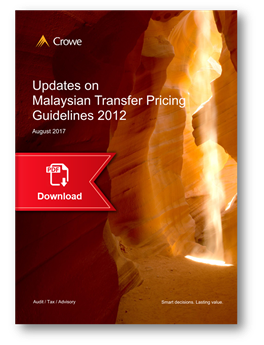Albania
Andorra
Armenia
Austria
Azerbaijan
Belgium
Bulgaria
Croatia
Cyprus
Czech Republic
Denmark
Estonia
Finland
France
Georgia
Germany
Greece
Hungary
Ireland
Italy
Kazakhstan
Kosovo
Latvia
Lithuania
Luxembourg
Malta
Moldova
Netherlands
Norway
Poland
Portugal
Romania
Serbia
Slovakia
Slovenia
Spain
Sweden
Switzerland
Tajikistan
Turkey
Ukraine
United Kingdom
Uzbekistan

Updates on Malaysian Transfer Pricing Guidelines 2012
August 2017
Transfer Pricing team of Crowe KL Tax Sdn Bhd

The Malaysian Transfer Pricing Guidelines 2012 have been updated by the Inland Revenue Board (IRB) of Malaysia to reinforce the existing standards based on current international taxation requirements. The updated Guidelines have been integrated in consistent with the Base Erosion and Profit Shifting (BEPS) Action Plan 8-10. The Chapters of the Guidelines that have been updated wef from 15 July 2017 are:-
• Chapter II – The Arm’s Length Principle
• Chapter VIII – Intangibles
• Chapter X – Commodity Transactions
• Chapter XI - Documentation
Major Highlights
How does the updated Transfer Pricing Guidelines impact businesses?
- The updated Chapter VIII: Intangibles might give rise to the increased use of profit split method to determine the arm’s length price of intangibles, which is practically difficult to imply as compared to other transfer pricing methodologies. Hence, it can lead to different views of IRB and taxpayer to apply the methodology and can lead to increased litigation cases and disputes between taxpayer and IRB.
- Taxpayers might need to develop and maintain detailed transfer pricing policy aligning with value creation and profit allocation from exploitation of intangibles as per the DEMPE functions performed by group entities.
- IRB may disregard commercial irrational transaction. As such, taxpayer needs to ensure substance over form in performing a controlled transaction in order to earn the profits. The cash boxes / entities located in tax haven countries / companies enjoying tax incentives are also at a higher risk of being challenged by the IRB on the factual substance.
- The burden of proof to justify the transfer prices are at arm’s length lays with the taxpayer. The taxpayer is required to maintain contemporaneous documentation to assist in demonstrating the taxpayer’s transfer pricing policy is appropriate for tax purposes.
- The volume of information to be included in the TP Documentation has significantly increased. Hence, the taxpayer needs to maintain good records and data should be readily available to facilitate extraction thereof. This may lead to increase in compliance cost to the taxpayer.
- Non-compliance of TP will give rise to a higher penalty as the penalty will be increased to 100% on the amount of tax undercharged in consequence of the incorrect return or incorrect information under Section 113(2)(b) of the Income Tax Act, 1967.
- The IRB wants to know in greater depth as to where the business drivers are as this will lead to scrutinizing transactions which could be seen as profit shifting.
- In determining the arm’s length price of a controlled transaction, besides performing FAR analysis, the IRB is now emphasizing on “Value Creation” which is in line with the BEPS. With this in place, it is difficult to identify the value creation and address the pricing for risk allocation for a controlled transaction undertaken between associated persons.
- Taxpayer should consider actual business transactions together with contractual arrangement that reflect economic reality in determining the transfer pricing between associated persons. If the contractual term is not aligned with the conduct of the actual transactions, the returns should be allocated accordingly. There is now greater emphasis on economic substance and what actually happens on the ground vs what happens on paper.
- The updated TP Guidelines has also elaborated on the Risk Analysis whereby the taxpayer needs to identify the risks, evaluate the risks and identify the risks assumed by each party.
- With the introduction of the new Chapter X: Commodity Transactions, taxpayer is required to provide reliable evidence of price setting policy as part of transfer pricing documentation in determining the transfer prices for commodity transactions. Due to the complexity of how commodity market operates – theory vs. actual businesses involved in commodities, it may be difficult to apply in the taxpayer’s actual business operations.
- Many commodity transactions have physical delivery of the goods at future dates. There can be a significant period of time between entering into a contract and taking delivery of the goods. As such, the quoted price of a commodity can fluctuate. How will IRB determine the pricing date of the commodity transaction? Would it be the date of entering the contract, the date of taking delivery of the goods, or the average of the commodity price within the period? Will IRB allow the approach of fixing the price at different periods that will be built into the contract? Further clarification is needed from the IRB. Continue reading >>>


